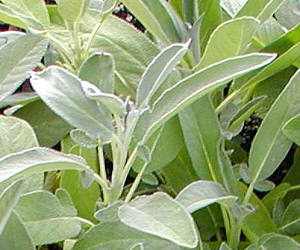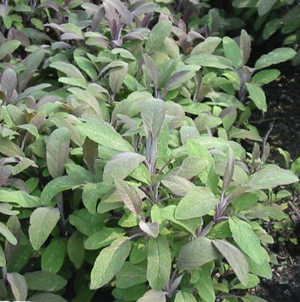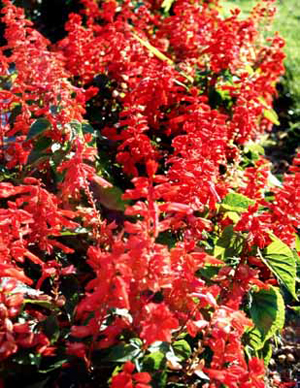Contents:
Common Names | Parts Usually Used | Plant(s) & Culture | Where Found | Medicinal Properties | Biochemical Information
Legends, Myths and Stories | Uses | Formulas or Dosages | Nutrient Content | How Sold | Warning | Resource Links | Bibliography
Scientific Names

- Salvia officinalis L.
- Labiatae
- Mint family
Common Names
- Garden sage
- Purple top sage
- Red sage
- Salvia
- Shu-wei-ts’ao (Chinese name)
- Wild sage
Parts Usually Used
Leaves
Back to Top

Description of Plant(s) and Culture
There are several varieties of sage; scarlet sage (S. splendens) red flowers and used for flavoring, and garden sage (S. officinalis) with aromatic leaves used, when dried, for seasoning meats, Cleveland sage (S. Clevelandi), Fruit salad sage (S. dorisiana), etc.
Others are: Clarey sage (S. sclarea), Mexican bush sage (S. leucantha), Variegated and Golden sage, Lyre-leaved sage (S. lyrata) is a folk remedy for cancer and warts, Pineapple sage, Purple sage (S. officinalis purpurea), Tricolor sage (S. officinalis tricolor), Holt’s mammoth sage (S. officinalis Holt’s mammoth), ornamental sage (S. farinacea victoria), meadow sage (S. pratense), berggarten, nana, rubriflora, elegans, icterina, Frieda Dixon, and on and on.
Salvia officinalis is a shrubby perennial plant that grows 2 feet high and is an aromatic, sun-loving plant with gray-green leaves and mauvish flowers. A strongly branched root system produces square, finely hairy stems which are woody at the base and bear opposite, downy, oblong leaves which may be entire or finely crenate. The floral leaves are ovate to ovate-lanceolate. Purple, blue, or white two-lipped flowers grow in whorls which form terminal racemes. Flowering time is June and July.
Other varieties:
Native Americans used a plant they called sage (Artemisia jrigida) or mountain ball sage. Blackfeet name “Ninny kaksa miss.” Arapaho name “Na ko ha sait.” Tea from the leaves was taken for coughs.
Bud sage (Artemisia spinescens) was cooked (the plant) and used the juice as medicine for the bladder. Paiute name “Kube.”
Native Americans also used Small Sage (Artemisia gnaphalodes) was used as a steam bath along with the tea for young girls approaching maturity. Paiute name “Kose wiup.” Shoshone name “Pava hobe.” Also called “Ba wa zip,” or young people’s tea.
Sweet sage (Artemisia dracunculoides), when dried, has a pleasing fragrance and was used in the Sun Dance with Small Sage (A. gnaphalodes).
Black Sage (Artemisia nova) as a laxative.
The Chinese use sage (Salvia japonica). Also, in China, the root of a related plant, (Salvia miltiorrhiza), called Dan shen, is used as a tonic herb.

Where Found
Sage is a native to the Mediterranean area, where it grows wild predominantly on mountain slopes and is commonly cultivated as a kitchen spice.
Naturalized and cultivated in the United States for the past 3 centuries.
Back to Top
Medicinal Properties
Diaphoretic, antiviral, carminative, stimulant, diurectic, antispasmodic, antidiarrheic, expectorant, tonic, aromatic, nervine, vermifuge, diuretic, stomachic, antiseptic, anithydrotic, astringent, promotes estrogen, antigalactagogue (decreases secretion of milk), uterine stimulant, reduces blood sugar levels
Back to Top
Biochemical Information
Volatile oil, resin, tannin, and a bitter principle, triterpenoids, flavonoids, estrogenic substances, saponins. The oil is composed of camphor, salvene, 15% cineol, 30% thujone, and pinene.
Back to Top

Legends, Myths and Stories
Sage, as its name implies, is said to carry powers of wisdom, as well as longevity. It was considered a valuable commodity in 17th century China, when merchants would trade 3 or 4 chests of tea for one chest full of sage.
Sage is known as a cure-all. Native Americans mixed the herb with bear grease to create an all-purpose salve.
Sage tea mixed with vinegar was given during the time of the plague.
The botanical name (Salvia officinalis) is derived from salvere, meaning “to be in good health.” In former times, sage was regarded as a sacred herb, often referred to as Salvia salvatrix, meaning “Sage the Savior.”
In Cyprus and Egypt, after a great plague, the women were forced to drink sage juice, to cause them to be more fruitful.
An ancient Chinese proverb says, “How can a man grow old who has sage in his garden”.
The Chinese highly regarded sage so much they gave the early Dutch and British traders twice the amount of their choicest Oriental teas in exchange for it.
The Chinese make fun of the American people; they buy tea at a high price for their tea; the Chinese buy sage from America for a low price and drink that for their tea. This tea will keep them healthy, the tea the Americans buy from the Chinese make them sick. Sage is very soothing and quieting to the nerves, while the tea Americans drink is a great cause of nervousness and headaches.
Traditionally, sage was associated with longevity, having the reputation of restoring failing memory in the elderly. It was also planted on graves.
When weaning a baby, or when it is desired to stop the flow of milk for reasons of sickness, etc., drink sage tea cold and it will cause the milk flow to cease.
Native Americans smoked sage leaves as pipe tobacco.
One man was reported to be overworked, worn out physically, even had a twitching of his eye that never stopped. He made a tea of the dried culinary herb using 2 heaped tsp. of herb. One wineglassful after meals. Twitching went away, he could rest better, looked rested and felt healthy.
Back to Top
Uses
Sage could almost be called a cure all. Sage acts as an antiseptic and soothes coughs and colds, flu, asthma, bronchitis, pneumonia, swollen glands, laryngitis, consumption, blood cleanser, laxative, increases menstrual flow, a relaxant for nervous disorders, headaches, and fevers, spermatorrhea, hair loss, calms nervousness, prevents night sweats, expels worms, treats quinsy, palsy, used in liver and kidney troubles, inflammations, typhoid, scarlet fever, measles, smallpox, soothes nervous troubles, relieves headaches. It also is used to inhibit perspiration. Good for the whole digestive system, dyspepsia, gas in the stomach. Can be used as a gargle or mouthwash to cure sore throats, canker sores, and sore gums, and as a lotion to heal ulcers, old wounds, varicose vein ulcers, sores, and skin eruptions. It will also staunch bleeding from wounds. Very effective for the treatment of cystitis.
Sage has always been thought of as good for the brain, improving the memory and, in some cases, even as a cure for insanity. It is a powerful nervine and will stop any involuntary trembling of the limbs. Also, a sprig of sage in the wardrobe will keep away moths. Sage is used for dandruff and is an effective hair tonic. It will make hair grow if the roots have not been destroyed. Once used for premature graying hair.
Lyre-leaved sage (Salvia lyrata) is wild and found in dry woodlands of the eastern United States and characterized by lyre-shaped basal leaves, has properties like those of garden sage; but it also contains acrid substances, and its crushed leaves have been used to remove warts. It is generally used in mixtures rather than alone.
Back to Top
Formulas or Dosages
Never steep herbs in aluminum containers.
Use leaves collected before flowering.
Infusion: steep 1 tsp. leaves in 1/2 cup water for 30 minutes. Take 1 cup per day, a tbsp. at a time. Children need smaller doses. Honey and lemon may be added to taste.
Powder: take 1/4 to 1/2 tsp. powdered leaves at a time.
Tincture: Take 15-40 drops, 3 to 4 times per day.
Standard infusion: or 3-9 grams; tincture, 10-30 drops.
Back to Top
Nutrient Content
The fresh leaves provide large amounts of vitamins A and C.
Back to Top
How Sold
Sold as a culinary spice.
Back to Top
Warning
It is inadvisable to “elevate” sage tea to the status of house tea, because its use over time can lead to intestinal disturbances. Extended or excessive use of sage can cause symptoms of poisoning.
Avoid use of sage for epileptics, sage contains thujone which can trigger a convulsion in epileptics.
Nursing mothers should avoid this herb as it suppresses mammary secretions.
Avoid therapeutic doses in pregnancy; it is a uterine stimulant. Small amounts used in cooking are quite safe.
Back to Top
Resource Links
Old Farmer’s Almanac: Growing Salvia-How to Plant, Grow, and Care for Salvia Flowers
Bibliography
![]() The Herb Book
The Herb Book, by John Lust, Bantam Books, 666 Fifth Avenue, New York, NY. copyright 1974.
 Old Ways Rediscovered
Old Ways Rediscovered, by Clarence Meyer, Meyerbooks, publisher, PO Box 427, Glenwood, Illinois 60425, published from 1954, print 1988
![]() Eastern/Central Medicinal Plants
Eastern/Central Medicinal Plants, by Steven Foster and James A. Duke., Houghton Mifflin Company, 215 Park Avenue South, New York, NY 10000
![]() Chinese Medicinal Herbs
Chinese Medicinal Herbs, compiled by Shih-Chen Li, Georgetown Press, San Francisco, California, 1973.
![]() Culpeper’s Complete Herbal & English Physician: Updated With 117 Modern Herbs
Culpeper’s Complete Herbal & English Physician: Updated With 117 Modern Herbs, by Nicholas Culpeper, Meyerbooks, publisher, PO Box 427, Glenwood, Illinois 60425, 1990, (reprint of 1814)
 Earl Mindell’s Herb Bible
Earl Mindell’s Herb Bible, by Earl Mindell, R.Ph., Ph.D., Simon & Schuster/Fireside, Rockefeller Center 1230 Avenue of the Americas, New York, New York 10020
![]() The Herbalist Almanac
The Herbalist Almanac, by Clarence Meyer, Meyerbooks, publisher, PO Box 427, Glenwood, Illinois 60425, copyright 1988, fifth printing, 1994
![]() Indian Uses of Native Plants
Indian Uses of Native Plants, by Edith Van Allen Murphey, Meyerbooks, publisher, PO Box 427, Glenwood, Illinois 60425, copyright 1958, print 1990
![]() Back to Eden
Back to Eden, by Jethro Kloss; Back to Eden Publishing Co., Loma Linda, CA 92354, Original copyright 1939, revised edition 1994
![]() Indian Herbalogy of North America
Indian Herbalogy of North America, by Alma R. Hutchens, Shambala Publications, Inc., Horticultural Hall, 300 Massachusetts Avenue, Boston, Massachusetts 02115, 1973
![]() The Complete Medicinal Herbal
The Complete Medicinal Herbal, by Penelope Ody, Dorling Kindersley, Inc, 232 Madison Avenue, New York, NY 10016, First American Edition, copyright 1993
![]() The Nature Doctor: A Manual of Traditional and Complementary Medicine
The Nature Doctor: A Manual of Traditional and Complementary Medicine, by Dr. H.C.A. Vogel; Keats Publishing, Inc., 27 Pine Street (Box 876) New Canaan, CT. 06840-0876. Copyright Verlag A. Vogel, Teufen (AR) Switzerland 1952, 1991
Herbal Gardening, compiled by The Robison York State Herb Garden, Cornell Plantations, Matthaei Botanical Gardens of the University of Michigan, University of California Botanical Garden, Berkeley., Pantheon Books, Knopf Publishing Group, New York, 1994, first edition
 The Magic of Herbs
The Magic of Herbs, by David Conway, published by Jonathan Cape, Thirty Bedford Square, London, England. (Out of print)
![]() Planetary Herbology
Planetary Herbology, by Michael Tierra, C.A., N.D., O.M.D., Lotus Press, PO Box 325, Twin Lakes. WI 53181., Copyright 1988, published 1992
 Taber’s Cyclopedic Medical Dictionary
Taber’s Cyclopedic Medical Dictionary, 15th Edition, F. A. Davis Company, 1915 Arch Street, Philadelphia, PA 19103
![]() Webster’s New World Dictionary
Webster’s New World Dictionary, Third College Edition, Victoria Neufeldt, Editor in Chief, New World Dictionaries: A Division of Simon & Schuster, Inc., 15 Columbus Circle, New York, NY 10023
 How Indians Use Wild Plants for Food, Medicine & Crafts
How Indians Use Wild Plants for Food, Medicine & Crafts, by Frances Densmore, Dover Publications, Inc., 180 Varick Street, New York, NY 10014, first printed by the United States Government Printing Office, Washington, in 1928, this Dover edition 1974
 The Magic of Herbs in Daily Living
The Magic of Herbs in Daily Living, by Richard Lucas, Parker Publishing Co. (1988).
 The Rodale Herb Book: How to Use, Grow, and Buy Nature’s Miracle Plants (An Organic gardening and farming book)
The Rodale Herb Book: How to Use, Grow, and Buy Nature’s Miracle Plants (An Organic gardening and farming book), edited by William H. Hylton, Rodale Press, Inc. Emmaus, PA, 18049., 1974
 Secrets of the Chinese Herbalists
Secrets of the Chinese Herbalists, by Richard Lucas, Parker Publishing Company, Inc., West Nyack, NY, 1987.
![]() The Yoga of Herbs: An Ayurvedic Guide to Herbal Medicine
The Yoga of Herbs: An Ayurvedic Guide to Herbal Medicine, by Dr. David Frawley & Dr. Vasant Lad, Lotus Press, Twin Lakes, Wisconsin, Second edition, 1988.
![]() Country Home Book of Herbs
Country Home Book of Herbs, Meredith Books, Editorial Dept. RW240, 1716 Locust Street, Des Moines, IA 50309-3023, copyright 1994
 The Healing Plants
The Healing Plants, by Mannfried Pahlow, Barron’s Educational Series, Inc. 250 Wireless Blvd., Hauppauge, NY 11788, 1992
